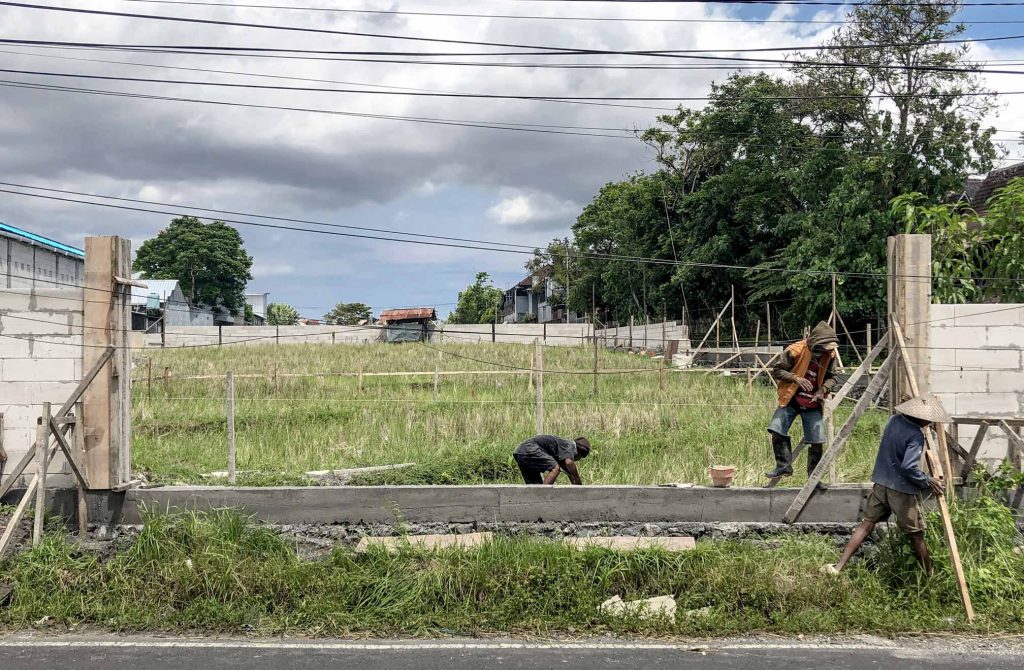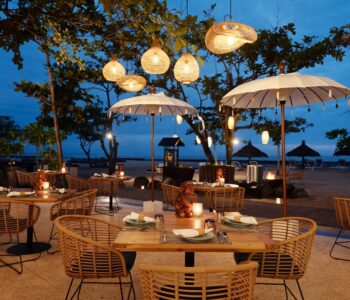Listen to this article through the NOW! Bali Podcast:
Change is inevitable, and Bali is no stranger to change. It’s no stranger to development and improvement, as well being no stranger to deterioration and damage. What governs whether this inevitable change is positive or negative is those who are part of it, who contribute to it and encourage one path over another.
Ever since Walter Spies painted scenes of an idyllic, exotic isle back in the 1930s, Bali has been haunted by a paradisiacal reputation. This expectation of paradise has persisted through the decades, putting pressure on the island to keep elements of life here unchanged. With every building or international brand introduced, every rice field paved over, this original brand of Bali is slowly whittled away.

Whilst the desire to preserve elements of Bali’s idyllic past is understandable, albeit romantic, just as understandable is the desire for Bali to shake off a ‘reputational anchor’ that may hinder it from what one might call progress. The city of Denpasar, for example, is a thriving urban centre, home to malls, Korean and Japanese fast-food chains and late-night coffee shops. It’s certainly not the Bali one envisions from abroad — but doesn’t every society deserve the opportunity to embrace modernity?
The answer to that question is yes, of course, but perhaps a more important question for Bali is whether modernity implies a shedding of an original identity, value and way of life. Further to that, must ‘progression’ always adopt cosmopolitan, city-inspired ways of life? From the changes one can see in Bali’s built environment, it appears things are already heading that way, even outside designated urban areas. Trying to grasp the pervasiveness of socio-cultural change is cumbersome and often complex, but the shifting land-use on the island can help us grasp how prevalent this transformation towards modernity is: urbanisation as the physical manifestation of modern life.
Land-use changes are important factors, as not only do they have (often unforeseen) side-effects upon the societies and cultures that interact with them; why and how these land-use changes have occurred also reveals the driving forces behind a lot of Bali’s transformation, ultimately questioning ‘Who is really controlling the changes we are seeing?’ These are important questions for an island so protective of its ‘persona’, so to speak, as too many changes can push Bali to becoming unrecognisable from what it is today.

Beauty is a Wound
Perhaps one of the most ironic facets of change in Bali is witnessing how areas transform, and often how those who lament said changes are simultaneously part of them.
Kuta, the area that kicked off the current ‘brand’ of tourism back in the late 70’s and early 80’s, was a surfer and backpacker enclave, where the charm of dirt roads and thatched-roof losmen (guesthouses) was all that was needed. Popularity spreads like wildfire, and quickly it transformed, heaving with hotels, nightlife, restaurants and shops. The original visitors of Kuta are likely no longer interested in this trans-mutated version of what was their dirt-road escape. The development of Canggu follows a similar story, an urbanisation that happened even faster than Kuta’s.
Around five years ago I remember asking friends what they liked about certain neighbourhoods like Umalas and Canggu, the answers were always in a similar vein: that these areas were still sparse and green, life felt slower, as if time itself was seduced by some native peacefulness. But everyone wants a little piece of this feeling for themselves, or seeks to capitalise on it, so homes and businesses sprout, taking over bushland and rice fields plot-by-plot. Modernity tips the scale and what we once loved, that humbling peace, is no more. We’re left with another gentrified, urbanised locale that speaks very little of its roots. Then the process begins again elsewhere.
In economics there is a phenomenon known as the resource curse, “the failure for resource-rich areas to benefit fully from their natural resource.” If beauty is Bali’s resource, then it is also its curse. Beauty is the original allure but also the final victim: “Beauty is a Wound”, as stated by Indonesian author Eka Kurniawan.

Dictating Changes
The changes certain areas in Bali have undergone — predominantly in South Bali, from Kuta to Canggu to Uluwatu — have largely been motivated by the financial pulls of tourism. This includes the hundreds of villas, myriad cafés, shophouses and more that populate the streets. Whilst one can argue it is the local population themselves who permit such changes, the dynamics aren’t quite as simple as that: tourism has not entirely been governed by the Balinese themselves! The Indonesian government, off-island investors and the international travel industry have had strong influences on how the tourism infrastructure and associated imported lifestyles have affected the development of the island.
Whilst tourism has been a gold mine and boon for Bali and the Balinese for decades, the industry’s near collapse has certainly made many reflect on tourism’s capacity for the future. Things are already changing in new directions; blue prints for large residential complexes are being advertised, the same for more malls and mega beach clubs. Will Bali become a home for new longterm residents? Will it become a simple weekend playground for Indonesia’s large cities, from where the largest investments are indeed originating? Developments are certainly leaning in this direction, but little is being discussed on what indirect effect these new urban landscapes and demographics will have on the atmosphere, culture, the very essence, of the locales in which they are being introduced.
In this new phase of Bali’s revival, whichever direction it goes, being aware of the powers that be becomes increasingly important. Who is driving the changes on the island, do they come from ‘inside’, and do they really have Bali’s best, longterm interests at heart?
Forgetting Dewi Sri
It isn’t just about the visual though. Land-use changes have a profound domino effect as nature, the people and the gods are so interconnected in Bali. Many traditions were born from the island’s agrarian society, with certain temples and rituals exclusive to types of farming, especially rice farming. Already in urban areas specific temples such as the pura ulun swi have been removed and rituals left behind, no longer necessary in today’s whirling world of commerce. How does Dewi Sri, the Goddess of Rice and Fertility, feel about being forgotten?
Bali’s protected and often celebrated subak system comes under threat too. We often take for granted the views in which we enjoy. The terraced rice fields that require painstaking hours of labour for the farmers to sculpt, till, plant and harvest. For those who don’t work under the sweltering heat of the sun, these swathing green landscapes are seen as nature, but they are not. They are the result of a symbiotic relationship between humanity and the island’s environment; with modernity calling, fewer and fewer farmers will manage this relationship and the rice field views everyone loves will begin to dwindle. What then of the image of Bali we thought would exist in perpetuity? This doesn’t even touch on the effects this will have on factors like food sovereignty or natural habitats.



How then does Bali find a balance between progress and preservation? How can the island ensure that modernity is not achieved at the cost of its already existing value — and who is deciding what this existing value really is? Nature and culture have been the longstanding foundation of the island’s inherent value and these have been, at least rhetorically, upheld through philosophies like Tri Hita Karana (creating balance among God, nature and humans). This has always been a good vision, a good place to start, but these three words will not be enough to curb the rapidly shifting mindset of an island, which, like much of the world, is being pulled by the addictive excitement, ambition and allure of contemporary ways of life.
Many of us love the Bali that exists today, where the conveniences of modern life exist side-by-side a plethora of natural environments, be it the sunny coastlines, the expanse of agricultural land or the stunning mountainsides and highlands. It is a strong human desire for us to want to be part of it, to enjoy it, but it is also a strong human desire to own and take control of it. This often results in becoming part of its transformation. Thus, collectively, we become part of the development that is slowly eating away at the very landscape we said we loved.
Therefore, a way to preserve parts of Bali is imperative to retaining its inherent value – a value shared by everyone. Green zones must be firmly established, incentives and subsidies for the agricultural industry must be given, supervision over the types and size of developments, zoning and moratoriums on certain buildings should be strengthened. Further to that, paths of economic growth that don’t require land-use changes for increased productivity must be encouraged. This can be rethinking landscapes as sites for eco-tourism, or rethinking the direction the Balinese develop their skills, outside of service-based industries and increasing opportunities in creativity, artisanship, business or indeed the digital economy.
At the end of the day, it is the Balinese themselves who must decide what they want their island to be and look like in the coming future. Financial rewards may be reaped today, especially in times of difficulty, but will these been seen as major regrets in the future?
It might be a cliché to once again bring up the great Joni Mitchell and her song Big Yellow Taxi, but her words are poignant and clearly not enough people have heeded her warning:
They paved paradise and put up a parking lot
With a pink hotel, a boutique, and a swinging hot spot
Don’t it always seem to go
That you don’t know what you got ’til it’s gone
They paved paradise and put up a parking lot
The Balinese must ensure that they do not recognise the current, inherent value of their island only when it has all but gone and it is too late.










